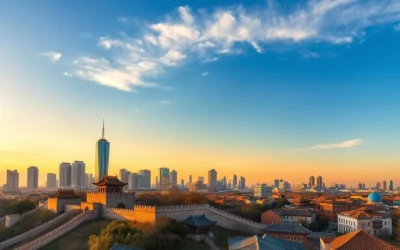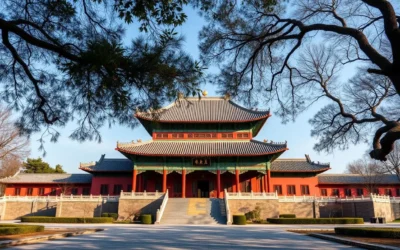✓ Accommodations✓ Flights✓ Rental Cars
If you’re looking for an unforgettable experience that combines wildlife conservation with breathtaking encounters, this destination is a must-visit. Known for its giant panda breeding programs, it offers a rare chance to see these gentle creatures up close while learning about efforts to protect them.
The chengdu panda bases are at the heart of this experience. These centers play a vital role in global conservation, housing over 120 pandas and offering insights into their care and preservation. Whether you’re a wildlife enthusiast or simply curious, you’ll find the blend of education and adventure truly inspiring.
From the iconic panda base tours to the serene landscapes, every moment here is designed to leave a lasting impression. Plan your visit with confidence, knowing you’re supporting a cause that matters.
Overview of Giant Panda National Park: History and Location
Discover the rich history and stunning location of one of the world’s most significant conservation areas. Established in 2016, this sanctuary spans over 27,000 square kilometers across Sichuan province, with extensions into Shaanxi and Gansu. It’s a testament to the commitment to preserving endangered species and their habitats.
Park History and Establishment
The park’s origins trace back to the merging of several nature reserves into a single ecological corridor. This transformation was driven by the need to create a unified space for wildlife conservation. The chengdu research base, established in 1987, played a pivotal role in this effort, housing over 150 pandas and simulating their natural habitat.
Today, the park stands as a symbol of global conservation efforts. It’s not just a home for pandas but also a hub for research and education. Visitors can learn about the challenges and triumphs of protecting these gentle creatures.
Where the Park is Located
Located primarily in Sichuan, the park includes key areas like Wolong and Foping. These regions are known for their lush landscapes and diverse wildlife. Traveling to the park takes planning, with journey times ranging from a few hours to a full day, depending on your starting point.
| Starting Point | Travel Time |
|---|---|
| Chengdu | 2-3 hours |
| Xi’an | 6-7 hours |
| Chongqing | 4-5 hours |
Whether you’re planning a tour chengdu or exploring the broader region, the park’s location makes it accessible yet remote enough to feel like a true escape. Its vast size ensures there’s always something new to discover.
How to Get to Giant Panda National Park
Planning your journey to this iconic wildlife sanctuary is easier than you think. Whether you’re starting from Chengdu or other nearby cities, multiple transportation options are available to make your trip smooth and enjoyable.
Traveling from Chengdu and Surrounding Cities
From Chengdu, you can reach the sanctuary by bus, train, or private car. Buses depart from Chadianzi, Xinnanmen, Shiyang, and North Bus Stations, with travel times averaging 3 hours. For a faster option, private cars take about 2 hours to cover the 130 km distance.
If you prefer a guided experience, booking a tour is a great choice. Many operators offer packages that include transportation and entry tickets, making your visit hassle-free.
Access from Chongqing, Xi’an, and Emeishan
Traveling from Chongqing or Xi’an? Buses and trains are your best bet. From Chongqing, the journey takes 4-5 hours, while Xi’an requires 6-7 hours. Emeishan is also accessible, with buses connecting directly to the sanctuary.
Keep in mind that ticket prices vary depending on your starting point and mode of transport. Budgeting ahead ensures you can focus on enjoying your visit.
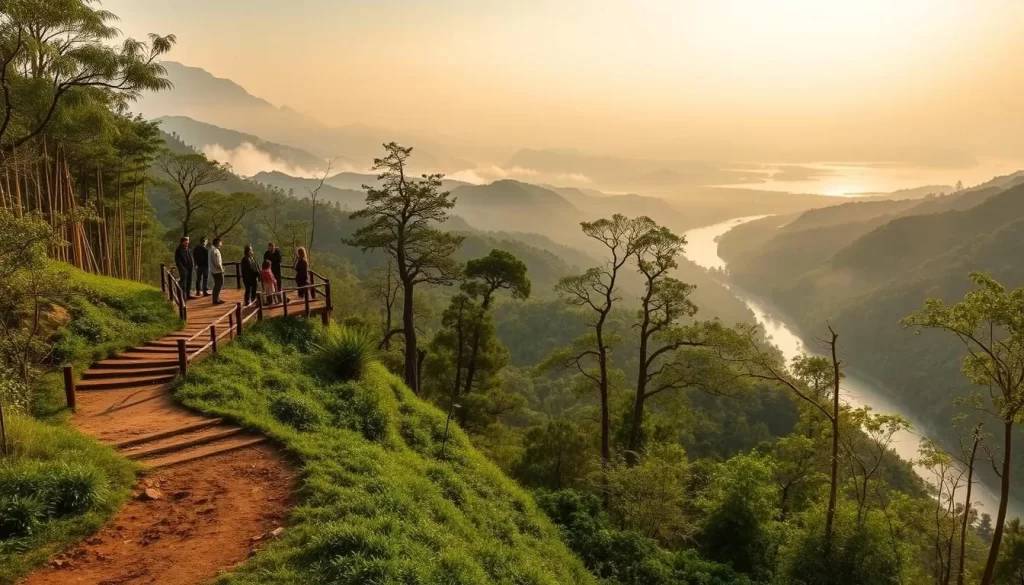
| Starting Point | Transportation | Travel Time |
|---|---|---|
| Chengdu | Bus, Train, Car | 2-3 hours |
| Chongqing | Bus, Train | 4-5 hours |
| Xi’an | Bus, Train | 6-7 hours |
| Emeishan | Bus | 3-4 hours |
For a personalized experience, consider DIY travel. This allows you to explore at your own pace and avoid crowded transit options. No matter how you choose to get there, your adventure awaits!
Geography and Biodiversity of the Park
Explore the diverse landscapes and rich biodiversity that make this sanctuary a haven for nature lovers. From towering peaks to lush valleys, the park’s geography is as varied as its wildlife. With altitudes ranging from 1,500 to 5,000 meters, the terrain offers something for every adventurer.
Stunning Mountain Landscapes and Rivers
The park’s rugged terrain is dominated by majestic mountains and winding rivers. These river systems are the lifeblood of the ecosystem, supporting a wide range of species. The golden light reflecting off the water at sunrise makes this a perfect spot for photography enthusiasts.
With over 3,000 unique peaks, the park’s landscapes are nothing short of breathtaking. Whether you’re hiking or simply soaking in the views, the mountains offer a sense of awe and wonder.
Flora and Unique Bamboo Forests
The park’s flora is equally impressive, with extensive bamboo forests that are essential to the diet of its most famous residents. These forests cover over 80% of the area, creating a lush, green haven.
Here’s what you’ll discover in the park’s flora:
- Over 118 species of rare plants.
- Bamboo varieties that thrive in the park’s unique climate.
- Wildflowers that bloom in vibrant colors during spring.
Planning your visit? Tickets are affordable, and the best time to explore is early morning when the park is less crowded. Whether you’re on a panda tour or exploring independently, the park’s natural beauty will leave you inspired.
Must-Do Attractions and Activities Inside the Park
Step into a world where conservation meets adventure, offering unforgettable experiences with nature’s most iconic creatures. From lush valleys to hands-on conservation programs, this sanctuary is packed with activities that cater to every visitor’s interests.
Wolong Valley and Foping Nature Reserve
Wolong Valley is a must-visit, located just 100 km from the city of Chengdu. The drive takes about 2 hours, but the journey is worth it for the stunning views and close encounters with wildlife. Here, you can explore the vast landscapes and learn about the efforts to protect endangered species.
Foping Nature Reserve is another gem, known for its rich biodiversity. It’s a perfect spot for hiking and wildlife photography. Early mornings are ideal for avoiding crowds and capturing the beauty of the reserve.
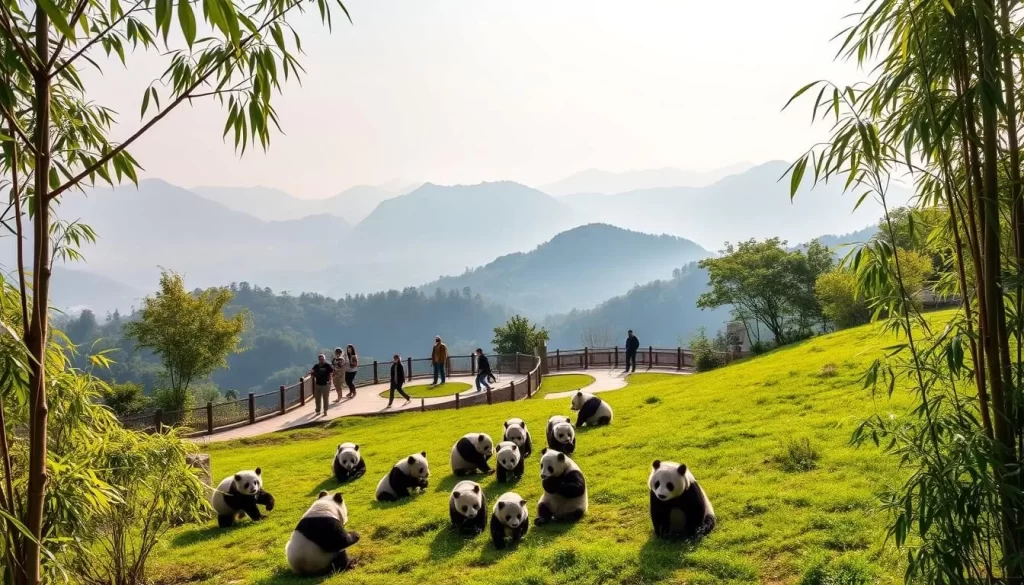
Dujiangyan Panda Research Base and Baishuijiang Reserve
The dujiangyan panda base is a highlight for many visitors. Located 1.5 hours from Chengdu, it offers unique volunteer opportunities and close-up views of these gentle creatures. The base is less crowded than others, allowing for a more personal experience.
Baishuijiang Reserve is another fantastic option. It’s a haven for nature lovers, with its pristine landscapes and diverse flora. Whether you’re exploring independently or on a guided tour, you’ll find plenty to admire.
Here’s how to make the most of your visit:
- Start early to avoid peak crowd times.
- Plan your route to include both Wolong Valley and the dujiangyan panda base in one day.
- Take advantage of volunteer programs for a hands-on experience.
With these tips, your visit to the park will be both memorable and rewarding. Whether you’re here for the wildlife or the scenery, these attractions are sure to leave a lasting impression.
Giant Panda National Park, China: Best Things to Do – Top Picks
Immerse yourself in a world where wildlife conservation meets unforgettable adventures, offering experiences that are both educational and inspiring. From intimate wildlife encounters to curated tours, this destination is a treasure trove of activities for every visitor.
Top Panda Experiences You Shouldn’t Miss
One of the highlights of your visit will be observing these gentle creatures during their active feeding times. The base offers guided tours that allow you to get up close and personal with the pandas, providing insights into their daily lives and conservation efforts.
For a more hands-on experience, consider volunteering at the dujiangyan panda base. Here, you can assist with feeding and care routines, making your visit truly memorable.
If you’re short on time, a half-day tour is a great option. These tours are designed to give you a comprehensive experience without taking up your entire day. You’ll still get to see the main attractions and learn about the conservation work being done.
Unique Excursions for Wildlife Observation
For those who prefer a more personalized experience, private tours are available. These can be tailored to your interests and often include car services for added convenience. Whether you’re exploring the lush valleys or the serene bamboo forests, these tours offer a deeper connection with nature.
Another must-see is the Wolong Valley, known for its stunning landscapes and diverse wildlife. A full-day excursion here allows you to explore at your own pace, with plenty of opportunities for photography and relaxation.
Here’s a quick guide to planning your visit:
- Opt for a half-day tour if you’re pressed for time.
- Consider a private tour for a more tailored experience.
- Don’t miss the feeding times at the base for the best wildlife observation.
These experiences are why this destination is considered one of the most extraordinary natural attractions in the world. Plan your visit today and create memories that will last a lifetime.
Discovering Local Indigenous Communities and Culture
Experience the vibrant traditions and rich heritage of local indigenous communities that surround this iconic destination. These groups, including the Qiang and Tibetan people, offer a unique window into their daily lives and cultural practices. Their presence adds depth to the region’s identity, making it a highlight for cultural enthusiasts.
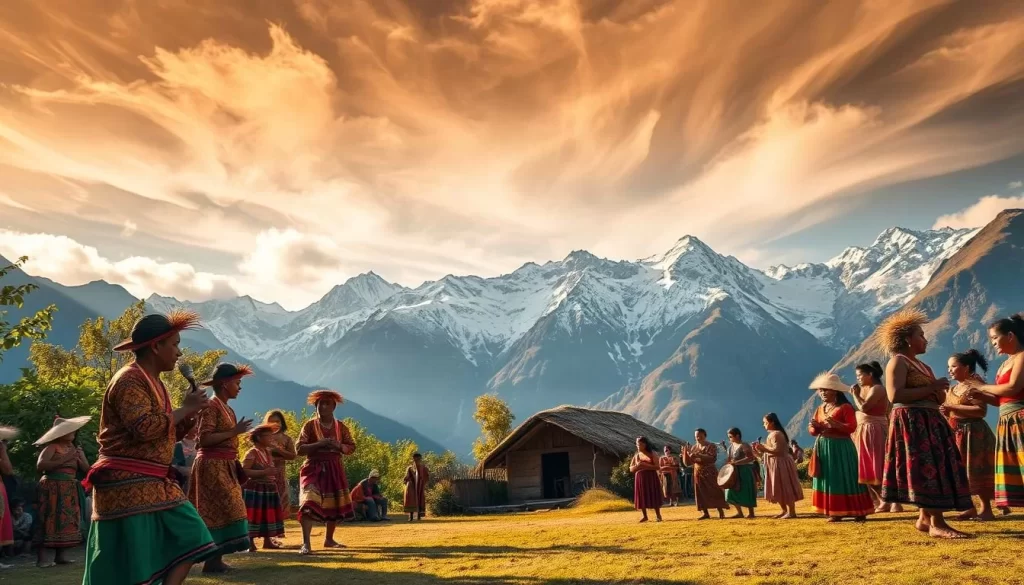
Qiang Ethnic Traditions
The Qiang people are known for their intricate craftsmanship and unique architectural styles. Their stone houses and embroidery work reflect centuries of tradition and skill. Visiting their villages in the morning allows you to witness their daily routines, from weaving to preparing traditional meals.
Their festivals, such as the Qiang New Year, are a highlight of the cultural calendar. These events showcase traditional dances, music, and rituals that have been passed down through generations. Participating in these celebrations offers an authentic glimpse into their way of life.
Tibetan Community Insights
The Tibetan community is deeply rooted in spiritual practices and daily rituals. Their monasteries are centers of learning and devotion, where you can observe prayer ceremonies and interact with monks. The morning chants are particularly mesmerizing, creating a serene atmosphere.
Their craftsmanship, especially in thangka painting and butter sculpture, is another highlight. These art forms are not only beautiful but also carry profound spiritual significance. Exploring these traditions helps you appreciate the community’s dedication to preserving their heritage.
For a deeper dive into the cultural diversity in China, consider visiting this link. It offers insights into other regions and their unique traditions, enriching your understanding of the country’s cultural tapestry.
Savoring Local Cuisine and Culinary Delights
Your journey to this region isn’t complete without indulging in the bold and flavorful local cuisine. From spicy Sichuan dishes to unique Qiang specialties, the food here is a highlight of any visit. Each bite tells a story of tradition and innovation, making dining an unforgettable part of your adventure.
Typical Sichuan and Qiang Dishes
Sichuan cuisine is famous for its fiery flavors, with dishes like Mapo Tofu and Kung Pao Chicken leading the way. These meals are crafted with chili and Sichuan peppers, creating a unique taste that’s hard to forget. For a milder yet equally delicious option, try bamboo-based dishes, a staple in the region.
Qiang cuisine offers a different but equally rich experience. Their dishes often feature local ingredients like edible bamboo and wild herbs. A visit to a Qiang village is the perfect way to enjoy authentic meals while learning about their culinary traditions.
Where and When to Dine
For the best dining experience, head to chengdu city, known as the culinary capital of the region. Here, you’ll find everything from street food stalls to high-end restaurants. Early evenings are the peak time to explore local markets, where the aroma of sizzling dishes fills the air.
If you’re on a private tour, ask your guide for recommendations on hidden gems. These lesser-known spots often serve the most authentic and flavorful meals. Don’t miss the chance to dine in traditional teahouses, where you can enjoy a leisurely meal while soaking in the local culture.
Here’s a quick guide to make the most of your culinary adventure:
- Try street food for a quick and tasty snack.
- Visit local markets during peak hours for the freshest options.
- Book a private tour to discover off-the-beaten-path dining spots.
For a deeper dive into Chinese cuisine, consider exploring this culinary tour. It offers a comprehensive way to experience the diverse flavors of the region, ensuring your trip is as delicious as it is memorable.
Where to Stay: Accommodations Near the Park
Finding the perfect place to stay near this iconic wildlife sanctuary can make your trip even more memorable. Whether you’re looking for luxury or budget-friendly options, there’s something for every visitor. From cozy guesthouses to well-rated hotels, your stay will be as comfortable as it is convenient.

Options in Wolong, Dujiangyan, and Chengdu
In Wolong, you’ll find accommodations close to the research bases, offering easy access to the park’s major attractions. Popular choices include Yehouxi Homestay, known for its high guest rating of 4.7/5, and Blossom Hill Ya’an, which offers family-friendly amenities. These sites are perfect for visitors who want to stay near the action.
Dujiangyan offers a mix of budget and mid-range hotels. The average cost for a one-night stay is around ₹ 1,216, making it an affordable option for many travelers. Hotels like Holiday Inn Resort Mengding Mountain are great for those seeking comfort and convenience, with facilities like parking and breakfast included.
Chengdu is ideal for those who prefer a bustling city vibe. The average cost for a one-night stay near the research base is US$48, with weekend rates climbing to US$218. Popular hotels like Crowne Plaza Chengdu Panda Garden and Zexi Mingdu Hotel offer pools and free Wi-Fi, ensuring a comfortable stay.
Here’s a quick guide to help you choose:
- Wolong: Stay close to the research bases with family-friendly options.
- Dujiangyan: Affordable stays with essential amenities.
- Chengdu: Luxurious hotels with city conveniences.
For more detailed options, check out this link to explore hotels that cater to your needs. Planning your stay has never been easier!
Planning Your Visit: Tips, Itineraries, and Local Hacks
Planning your trip to this unique destination can be both exciting and rewarding with the right tips and tricks. Whether you’re a first-time visitor or a seasoned traveler, knowing the best times to go and how to make the most of your day can transform your experience.
Best Time to Visit Based on Weather and Crowds
The ideal time to explore is between April and October, when the weather is mild and the landscapes are lush. During these months, temperatures range from 15°C to 30°C, making it perfect for outdoor activities. Avoid peak seasons like school holidays to enjoy quieter moments by the river and fewer crowds.
If you prefer cooler weather, consider visiting during the off-season from November to March. While temperatures can drop to -5°C, the serene atmosphere and lower ticket prices make it a great option.
Suggested Itineraries and Activity Options
For a half-day trip, focus on the main attractions like the research bases and nearby bamboo forests. Start early to catch the morning feedings and enjoy the peaceful surroundings.
If you have a full day, explore the scenic valleys and nature reserves. Combine activities like hiking and wildlife photography for a well-rounded experience. Insider tip: visit the river areas in the late afternoon for stunning views and fewer visitors.
Here’s a quick guide to help you plan:
- Half-day: Research bases and bamboo forests.
- Full-day: Valleys, reserves, and river spots.
- Insider hack: Early mornings and late afternoons are the best times to visit.
For more detailed planning, check out this resource to make your trip seamless and enjoyable.
Conclusion
This destination offers a perfect blend of natural beauty, cultural richness, and unforgettable experiences. From observing gentle creatures in their habitat to exploring lush landscapes, every moment here is designed to inspire. The region’s dedication to conservation and its vibrant local traditions make it a standout choice for any traveler.
Whether you’re a wildlife enthusiast or a cultural explorer, there’s something for every person to enjoy. The unique attractions and hands-on activities ensure your visit is both educational and memorable. With over 120 residents at the research base, you’ll have plenty of opportunities to connect with nature.
Start planning your trip today and immerse yourself in this extraordinary experience. For more details on tours and activities, check out this comprehensive guide. Your adventure awaits!
The above is subject to change.
Check back often to TRAVEL.COM for the latest travel tips and deals.

